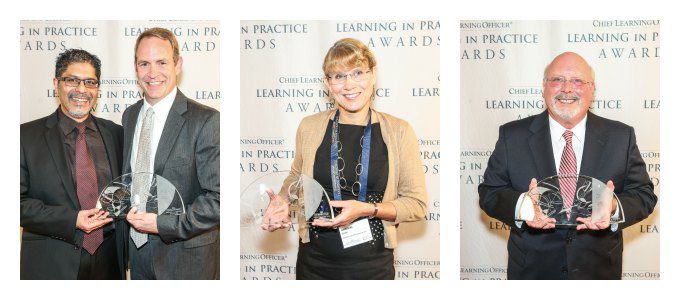
by Sarah Sipek
December 8, 2015
Gold
Intrepid Learning Inc.
When Microsoft Corp. decided to transition its business from on-premise enterprise software to cloud-based solutions the company discovered a learning gap that needed to be filled. Suddenly the 15,000 employees in its sales force worldwide needed to increase their business acumen — quickly. The entire sales force needed to be up to speed within an 18- to 24-month time frame.
To facility learning on such a large scale, Microsoft partnered with Intrepid Learning Inc. to develop a massive open online course model. Above all else, Microsoft wanted to create a program that would facilitate bidirectional and peer-to-peer dialog so employees would feel they were getting an effective learning experience.
The resulting solution consists of three eight-week courses: business strategy and financial acumen, business model innovation and persuasion and influence with the C-suite. Information is delivered through videos, case studies, discussion, job aids, quizzes and weekly assignments.
MOOCs are not a new learning model, but Intrepid used several key strategies to drive participation at Microsoft, the first of which was exclusivity. The program is nomination-based for high performers. The inherent competition led to twice the normal enrollment for the pilot course.
Microsoft also wanted to be conscious of its learners’ time. Course work is limited to three hours per week, which meant the Intrepid learning platform had to deliver a mobile-first approach to learning. Course content is delivered via video with a collaborative platform available for students to interact with professors and Microsoft experts.
The results have been promising. Microsoft set a goal of 500 learners enrolling in the first course. The company had 1,014 enroll plus a wait list, and 85 percent of those employees completed the program.
Silver
SweetRush Inc.
The Bridgestone Education Network was designed as a robust program for education-based marketing to engage a millennial salesforce to learn about and promote Bridgestone brand tires. In 2012, Bridgestone partnered with SweetRush Inc. to develop a solution that could “reach and teach” this demographic through mobile, gaming, 3-D, animation and interactive portal design.
Since its rollout in 2013, the program has been successful, but initial results were not enough. Bridgestone wants to increase course completion rates and extend the reach of the program to other audiences and demographics. To accomplish this goal, Bridgestone continued its partnership with SweetRush and focused its attention on the intrinsic and extrinsic motivation of its workforce.
Extrinsically, the salesforce was rewarded through contests, and intrinsically it was motivated by learning new sales skills. Two new video-game style offerings allow salespeople to acquire new skills on an engaging platform.
The techniques are working. Learners have completed more than 154,000 courses, a 36 percent increase from 2014, the company said.
Bronze (tie)
Xerox Global Learning Services
In support of EY’s need for employees to acquire knowledge and skills faster than a traditional classroom model can provide, Xerox Global Learning Services helped the company create a “model” program. Using e-learning, virtual classrooms and just-in-time resources such as three- to five-minute “teach videos,” the organization was able to expand the amount of learning available and increase the timeliness and effectiveness of offerings.
Bronze (tie)
Bottom-Line Performance Inc.
Roche Diagnostics partnered with Bottom-Line Performance Inc. to reimagine its cobas customer training with a blended curriculum that emphasizes daily tasks and practice. The new approach decreased the time it takes customers to build competence by using analyzer technology to create a personalized learning solution for each participant. This helped Roche generate positive learner feedback, decrease support calls and drive a 35 percent cost reduction.



